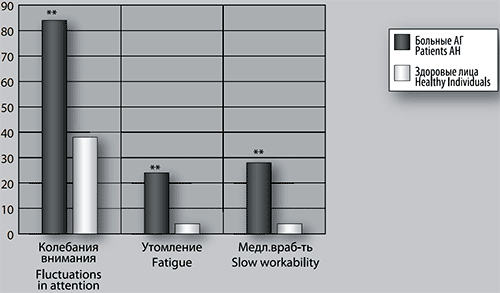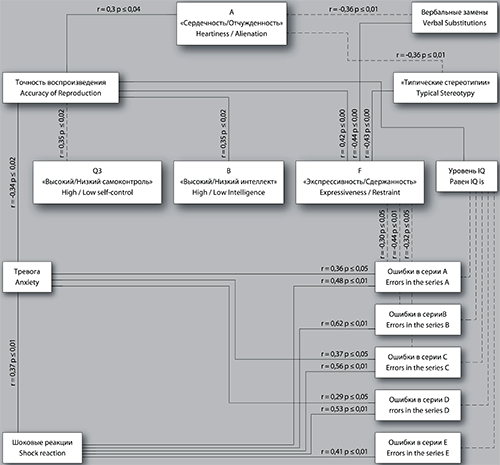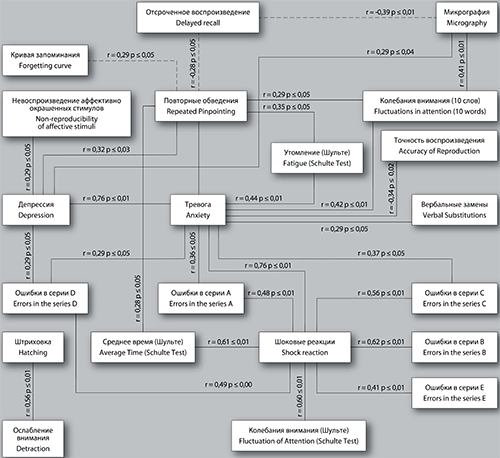Article
Pervichko E.I., Korsakova N.K., Darevskaya M.A. (2019) The role of motivation in the productivity of cognitive activity in patients with arterial hypertension in the middle age-movement practice as a method of self-knowledge and education a creative personality. National Psychological Journal, [Natsional’nyy psikhologicheskiy zhurnal], 12(4), 72–91.
Abstract
Background. One of the issues of modern health care the frequent arterial hypertension (AH) in people of the so-called middle age. There is a decrease in the productivity of mental activity accompanied by anxiety in the form of «cognitive dissatisfaction» with the corresponding experiences. Features and causes of cognitive dysfunctions in patients with hypertension require special study. Its results are important not only for understanding the central mechanisms of the disease, but also for the development of diagnostic and therapeutic procedures, preventive, correctional and rehabilitation programs. They are determined by the relevance of clinical and psychological studies of the syndromes of cognitive dysfunctions and factors that determine cognitive functioning in hypertension in the middle age.
The Objective is the assessing of motivational and emotional factors to the qualitative characteristics of cognitive activity in the middle-aged patients with AH who are unaware of the medical qualifications of their disease.
Design. The study and interpretation of its results was carried out in accordance with the principles of psychological syndrome analysis (school of L.S. Vygotsky - A.R. Luria - B.V. Zeigarnik). The research program included the diagnosis of emotional and personal characteristics using the Russian-language version of the 16-factor Cattell personality questionnaire (Cattell, Schuerger, 2003; Kapustina, 2006) and the Pictogram methodology (Zeygarnik, 1962; Rubinstein, 1970), diagnostics of general intelligence using the “Raven’s Progressive matrices” (Raven, et al., 2012; Davydov, Chmykhova 2016), and also the study of “qualitative” features of cognitive processes using pathopsychological examination (Zeigarnik, 1986). We examined 48 patients (52.3±6.6 years) with Stage 2 hypertension, Grade 1-2, unaware of the diagnosis and 54 almost healthy people, comparable to patients by gender, age and educational level.
Results. 84% of hypertensive patients with high and medium intelligence showed signs of a decrease in cognitive activity. A meaningful interpretation of the results of the study using the methodological principles of psychological syndrome analysis (the school of L.S. Vygotsky - A.R. Luria - B.V. Zeygarnik) showed that in the structure of disturbances of cognitive processes in hypertension, disturbances in the dynamics of mental processes expressed by labile mental activity and rapid exhaustion, based on a decrease in neurodynamic support of mental activity. Reduced cognitive functioning is also influenced by the emotional and personal characteristics of patients, especially the deficiency of harmony in their motivational sphere. The study of thinking showed the diversity of opinions in 43% of patients and signs of distortion of the generalization process in 24% of patients with hypertension. Correlation analysis data have confirmed the relationship between the frequency of occurrence of these phenomena and the frequency of decrease in the productivity of cognitive activity. Patients with hypertension in the middle age unaware of the presence of this diagnosis, differ from healthy individuals in the greater disharmony of personality traits. They are characterized by a tendency to restrain affect, personal rigidity, lack of flexibility of emotional manifestations, with persistence in achieving goals and overall dominance, and also increasing values on the scales of anxiety and depression. The levels of anxiety and depression are statistically related to the productivity of the cognitive functioning in patients with hypertension.
Conclusion. Using the methodological principles of psychological syndrome analysis showed that the cognitive processes in untreated middle-aged hypertensive patients can be described as cognitive dysfunction syndrome, where two syndrome factors can be considered significant: neurodynamic and motivational ones. The research results contribute to the solution of personal and «actually intellectual» processes correlation in solving problems in normal and pathological conditions. They expand the understanding of the etiology and pathogenesis of hypertension, and allow individualizing strategies for medical and psychological care for patients with hypertension.
Accepted: 12/14/2019
Pages: 72-91
DOI: 10.11621/npj.2019.0408
PDF: Download
Keywords: syndrome-based approach by L.S.Vygotsky-A.R.Luria-B.V.Zeigarnik; psychological syndrome analysis; syndromic factor; arterial hypertension (AH); cognitive processes; cognitive dysfunctions; cognitive functioning; cognitive disorders; emotional and personal characteristics; motivation;
Available Online 31.12.2019
Acknowledgments
This work was supported by the Russian Federal Property Fund, project 17-06-00954-OGN "Comprehensive topical diagnosis of cognitive disorders in essential arterial hypertension
Table 1. Patients with arterial hypertension (AH) and healthy individuals with signs of a decrease in cognitive activity (%)
|
Assessment Parameter |
Group |
|
|
Patients with AH |
Healthy Individuals |
|
|
Thinking |
82** |
20 |
|
Memory (direct memorising) |
16* |
12 |
|
Memory (indirect memorising) |
84** |
24 |
|
Attention |
84** |
36 |
NB: differences between groups are: * – р≤0,05; ** – р≤0,001.

Fig. 1. The frequency of attention disorders in groups in patients with arterial hypertension (AH) and healthy individuals (%)
NB: differences between groups are: ** - p≤0.001.
Table 2. The frequency of occurrence of impaired natural auditory-speech memory (direct memory) in patients with arterial hypertension (AH) and in healthy individuals (%)
|
Assessment Parameter |
Groups |
|
|
Patients with AH |
Healthy Individuals |
|
|
Reduced memory (less than 4 items reproduced) |
19** |
8 |
|
Sawtooth Curve |
32* |
16 |
|
Plate Curve |
8 |
0 |
|
Contamination |
3 |
0 |
|
Decreased amount of delayed auditory-speech memory (Decreased memory productivity) |
19** |
4 |
|
Paraphases |
31** |
16 |
NB: differences between groups are: * – р≤0.05; ** – р≤0.001.

Fig. 2. Average values of the erroneous decisions according to the “Progressive Raven’s Matrices” in patients with arterial hypertension (AH) and healthy individuals
NB: differences between groups are: * – р≤0.05; ** – р≤0.001.
Table 3. Mean value of the emotional-personal sphere in patients with arterial hypertension (AH) and healthy individuals
|
Assessment Parameter |
Group |
|
|
Patients with AH |
Healthy Individuals |
|
|
A » Heartiness / Alienation (Cattel Test) |
4.63* |
5.59 |
|
F Expressiveness / Restraint (Cattel Test) |
3.22* |
4.36 |
|
Shock reaction (Pictogram) |
4.93** |
2.08 |
|
Hatching Pattern (Pictogram) |
0.43** |
0.01 |
|
Repeated Pinpointing (Pictogram) |
4.54** |
1.13 |
|
Anxiety (Hamilton Scale) |
2.12** |
0.05 |
|
Depression (Hamilton Scale) |
0.96** |
0,05 |
NB: differences between groups are: * – р≤0,05; ** – р≤0,01.

Fig. 3. Correlation relationship between the assessment parameters of cognitive activity and the emotional and personal characteristics of patients with arterial hypertension (AH)
Legend: dashed line – negative connection, solid line – positive connection, green – Cattel Test, purple – Pictogram, black – IQ (Raven’s Matrices), light-blue - error in each series of "Progressive Raven’s Matrices", red - severity of anxiety (Hamilton scale).

Fig. 4. Correlation between anxiety, depression and cognitive performance in patients with arterial hypertension (AH)
Legend: dashed line – negative connection, solid line – positive connection, green – Schulte table, orange – memory, 10 words technique, purple - Pictogram, black - severity of depression (Hamilton scale), light-blue - error in each series of "Progressive Raven’s Matrices", red - severity of anxiety (Hamilton scale).
References:
Asmolov A.G. (2011). Psychology of Personality. Cultural and historical understanding of human development. Moscow, Smysl.
Bleicher V.M., Kruk I.V., & Bokov S.N. (2002). Practical pathopsychology. Moscow; Voronezh: MODEK.
Broytigam V., Christian P., & Rad M. (1999). Psychosomatic medicine: textbook. Moscowб Meditsina.
Buklina S.B. (2019). Disturbances of higher mental functions with damage to the deep and stem structures of the brain. Moscow, MEDpress-inform,
Buklina S.B. (1999). Memory impairment and deep brain structures. [Zhurnal nevrologii i psikhiatrii imeni S.S. Korsakova],9, 10–15.
Carlson S.H., & Wyss J.M. (2011). Mechanisms Underlying Hypertension and Obesity: A Melanocortin Linkage in the Brain. Hypertension, 57, 375–376. doi: 10.1161/HYPERTENSIONAHA.110.161729
Cattell H. E., & Schuerger J. M. (2003). Essentials of the 16PF. NY.: John Wiley & Sons,
Cerhan J.R., Folsom A.R., Mortimer J.A., Shahar E., Knopman D.S., McGovern P.G., Hays M.A., Crum L.D., & Heiss G. (1998). Correlates of cognitive function in middle-aged adults: Atherosclerosis Risk in Communities (ARIC) Study Investigators. Gerontology,44, 95–105. doi: 10.1159/000021991
Cohen R.A. (2011). Neuroimaging of cardiovascular disease. In R.A. Cohen & L.H. Sweets (Eds.), Brain Imaging in Behavioral Medicine and Clinical Neuroscience. New York: Springer, 215–256. doi: /10.1007/978-1-4419-6373-4_15
Davidovich I.M., Afonaskov O.V., & Staroverova Yu.K. (2009). The state of memory, attention and thinking in young males with arterial hypertension. [Sistemnye gypertenzii]. 4, 59–63.
Davydov D.G., & Chmykhova E.V. (2016). Application of the test “Raven’s Standard progressive matrices” in the time limit mode. [Voprosy Psikhologii], 4,129–139.
Denollet J. (2000). Type D personality. A potential risk factor defined. J Psychosom Res, 49, 255–266. doi: 10.1016/S0022-3999(00)00177-X
Dima-Cozma C. et al. (2014). Socioeconomic status and psychological factors in patients with essential hypertension. In Dima-Cozma C., Mitu F., Szalontay A., & Cojocaru D.-C. Revista de CercetaresiInterventieSociala, 44, 147–159.
Douglas K. M., Porter R. J., Knight R. G., & Maruff P. (2011). Neuropsychological changes and treatment response in severe depression. British journal of psychiatry. Vol. 198, 115–122. doi: 10.1192/bjp.bp.110.080713
Dregan A., Stewart R., & Gulliford M.C. (2013). Cardiovascular risk factors and cognitive decline in adults aged 50 and over: a population-based cohort study. Age Ageing, 42, 338–345. doi: 10.1093/ageing/afs166
Dunbar F. (1954). Emotions and bodily changes. N.Y.: Columbia Univ. Press.
Gotlib H., & Joormann J. (2010). Cognition and Depression: current status and future directions. Annual revue clinical psychology, 6, 285–312. doi: 10.1146/annurev.clinpsy.121208.131305
Grabe H. J., Schwahn C., & Barnow S. (2010). Alexithymia, hypertension, and subclinical atherosclerosis in the general population. J. Psychosom. Res, 68, 139–147. doi: 10.1016/j.jpsychores.2009.07.015
Grace W. J., & Gracham D. T. (1952). Relationship of specific attitudes and emotions to certain bodily diseases. Psychosom. Med., 14, 243–251. doi: 10.1097/00006842-195207000-00001
Hamer M. (2010). Adherence to healthy lifestyle in hypertensive patients: ample room for improvement? Journal of Human Hypertension, 24, 559–560. / doi: 10.1038/jhh.2010.61
Hamilton M. (1960). A rating scale for depression. Journal of Neurology, Neurosurgery and Psychiatry, 23, 56–62. doi: 10.1136/jnnp.23.1.56
Hamilton M. (1959). The assessment of anxiety states by rating. Br J Med Psychol, l(32), 50–55. doi: 10.1111/j.2044-8341.1959.tb00467.x
Hausteiner C., Klupsch D., Emeny R., Baumert J., & Ladwig K. (2010). Clustering of negative affectivity and social inhibition in the community: prevalence of type D personality as a cardiovascular risk marker. Psychosom. Med, 72, 163–171. doi: 10.1097/PSY.0b013e3181cb8bae
Henrique C. S., Muela H. C., Costa-Hong V. A., Yassuda M. S., Moraes N. C., Memória C. M., Machado M. F., Macedo T. A., Shu E. B., Massaro A. R., Nitrini R., Mansur A. J., & Bortolotto L. A. Hypertension severity is associated with impaired cognitive performance. J. Am. Heart. Assoc. Severity, 6, e004–579.
Hughes T.M., & Sink K.M. (2016). Hypertension and Its Role in Cognitive Function: Current Evidence and Challenges for the Future. American Journal of Hypertension, 29(2), 149–157. doi: 10.1093/ajh/hpv180
Iadecola C., Yaffe K., Biller J., Bratzke L.C., Faraci F.M., Gorelick P.B., Gulati M., Kamel H., Knopman D.S., Launer L.J., Saczynski J.S., Seshadri S., Zeki A., & Hazzouri A. (2016). Impact of Hypertension on Cognitive Function: A Scientific Statement From the American Heart Association. Hypertension, 68(6), e67–e94. doi: 10.1161/HYP.0000000000000053
Jennings J.R., & Heim A.F. (2012). From brain to behavior: hypertension's modulation of cognition and affect. Int J Hypertension. Article ID 701385. doi: 10.1155/2012/701385
Kapustina A.N. (2006). Multifactorial personality technique of R. Cattel: textbook. St. Petersburg, Rech.
Khersonskiy B.G. (2000). Method of pictograms in psychodiagnostics. St. Petersburg, Sensor, 128.
Khomskaya E.D. (1987). Neuropsychology. Moscow, Izdatel’stvo Moskovskogo Universiteta.
Korsakova N.K., & Varako N.A. (2005). On the determinants of the formation of neurocognitive disorders in arterial hypertension at a later age. [Vestnik Moskovskogo universiteta]. Series 14, Psychology, 4, 16–23.
Korsakova N.K., & Moskovichute L.I. (1988). Clinical neuropsychology. Moscow, Izdael’stvo Moskovskogo Universiteta.
Korsakova N.K., Ostroumova O.D., Varako N.A., Mamaev V.I., Nesterova M.V., & Martynov A.I. (2001). The effect of long-term therapy with fosinopril and amlodipine on the memory of elderly patients with mild and moderate essential arterial hypertension. Kardiologiya, 41(8), 47–51.
Korsakova N.K., & Roshchina I.F. (2018). The concept of A.R. Luria on the three functional blocks of the brain and the neuropsychological syndrome of normal aging. In N.V. Zvereva, I.F. Roschina (Eds.) [Metodologicheskie i prikladnye problemy meditsinskoy (klinicheskoy) psikhologii: kollektivnaya monografiya]. Moscow, Sam Poligrafist, 203–211.
Kochenov M.M., & Nikolaeva V.V. (1978). Motivation for schizophrenia. Moscow, Izdael’stvo Moskovskogo Universiteta.
Krzesinski J., & Leeman M. (2011). Practical issues in medication compliance in hypertensive patients. Research Reports in Clinical Cardiology, 2, 63–70.
Leontiev A.N. (1975). Activity. Consciousness. Personality. Moscow, Politizdat.
Longinova S.V. (1998). The study of thinking inpatients using the method of "pictograms". In N.L. Belopolskaya (Ed.) [Patopsikhologiya: Khrestomatiya]. Moscow, Izdatel’stvo URAO, 96–108.
Luria A.R. (1969). Higher cortical functions of a person and their disturbances in local brain lesions. Moscow, Izdatel’stvo Moskovskogo Universiteta.
Luria A.R. (1976). Neuropsychology of memory. In 2 vols. Vol. 2. Memory impairment in deep brain lesions. Moscow, Pedagogika,
Luria A.R. (1973). Fundamentals of Neuropsychology. Moscow, Izdatel’stvo Moskovskogo Universiteta.
Mendelevich V.D., & Solovieva S.L. (2002). Neuroscience and psychosomatic medicine. Moscow, Medpress-Inform.
Mann S.J. (2012). Psychosomatic Research in Hypertension: The Lack of Impact of Decades of Research and New Directions to Consider. The Journal of Clinical Hypertension, 14(10), 657–664. doi: 10.1111/j.1751-7176.2012.00686.x
Moritz S., Birkner C., Kloss M., Jahn H., Hand I., Haasen C., & Krausz M. (2002). Executive functioning in obsessive-compulsive disorder, unipolardepression, and schizophrenia. Archives of Clinical Neuropsychology, 17, 477–483. doi: 10.1093/arclin/17.5.477
Nekrasova E.M. (1987). Features of cognitive activity and the emotional-personal sphere in patients with arterial hypertension in early and reversible forms of cerebrovascular accident: Ph.D. in Psychology, Thesis. Moscow, 231.
Obisesan T.O., Obisesan O.A., Martins S., Alamgir L., Bond V., Maxwell C., & Gillum R.F. (2008). High blood pressure, hypertension, and high pulse pressure are associated with poorer cognitive function in persons aged 60 and older: the Third National Health and Nutrition Examination Survey. J Am Geriatr Soc, 56, 501–509. doi: 10.1111/j.1532-5415.2007.01592.x
Ostroumova O.D., Korsakova N.K., & Varako N.A. (2009). Arterial hypertension in the elderly and the state of higher mental functions. The possibilities of antihypertensive therapy arifonometard in the prevention of dementia. [Sistemnye gipertenzii], 4, 63–66.
Ostroumova O.D., Pervichko E.I., & Zinchenko Yu.P. (2016). Psychological characteristics of patients with stress-induced arterial hypertension: dysregulation of emotions as a central link in pathogenesis. Kardiologiya, 9, 40–49. doi: 10.18565/cardio.2016.9.40-49
Ostroumova T.M., Parfenov V.A., & Ostroumova O.D. (2017). Arterial hypertension and cognitive impairment: a view from the perspective of evidence-based medicine. [Neyrologiya, neyropsikhiatriya, psikhosomatika], 9(4), 70–76. doi: /10.14412/2074-2711-2017-4-70-76
Parfenov V.A., Ostroumova T.M., Ostroumova O.D., Perepelov V.A., & Perepelova E.M. (2018). Diffusion-tensor magnetic resonance imaging in the diagnosis of damage to the white matter of the brain in middle-aged patients with uncomplicated essential arterial hypertension. [Neyrologiya, neyropsikhiatriya, psikhosomatika],10(2), 20–26. doi: 10.14412/2074-2711-2018-2-20-26
Pervichko E.I. (2016). Regulation of emotions in patients with cardiovascular diseases: Doctoral Thesis. Moscow.
Pervichko E., Ostroumova T., Darevskaya M., Perepelova E., Perepelov V., Vartanov A., Kozlovskiy S., Ostroumova O., Parfenov V., & Zinchenko Y. (2018). A psychophysiological study of cognitive disorders in naïve middle-age patients with uncomplicated essential hypertension and white matter lesions. European Psychiatry. V. 48, 114.
Popov Yu.V., & Pichikov A.A. (2012). Early diagnosis of anxiety-phobic disorders in adolescents in general medical practice. Guidelines. St. Petersburg: NIPNI imeni V.M. Bekhtereva.
Raven J., Raven J.K., & Cort J.H. (2012). A Guide to Raven's Progressive Matrices and Vocabulary Scales. Moscow, Kogito Tsenter. doi: 10.1037/t10910-000
Raven J., Raven J.C., & Court J.H. (2003). Manual for Raven's Progressive Matrices and Vocabulary Scales. San Antonio, TX: Harcourt Assessment.
Rubinstein S.L. (1989). Bases of General Psychology. In 2 vols. Vol. 2. Moscow, Pedagogika.
Rubinstein S.Ya. (1970). Experimental methods of pathopsychology and the experience of their use in the clinic: a practical guide. Moscow, Meditsina.
Rukavishnikov A.A., & Sokolova M.V. (1995). R. Cattell-95 factor personality questionnaire: usage guide. St. Petersburg, Imaton.
Rutledge T., & Hogan B.E. (2002). A quantitative review of prospective evidence linking psychological factors with hypertension development. Psychosom. Med, 64, 758–766. doi: 10.1097/01.PSY.0000031578.42041.1C
Saxby B.K., Harrington F., McKeith I.G., Wesnes K., & Ford G.A. (2003). Effects of Hypertension on Attention, Memory, and Executive Function in Older Adults. Health Psychology, 22(6), 587–591. doi: 10.1037/0278-6133.22.6.587
Sinkova G.M. (2007). Epidemiology of arterial hypertension. [Sibirskiy Meditsinskiy Zhurnal], 8, 5–10.
Sokolov E.I., Ostroumova O.D., Pervichkov E.I., Guseva T.F., & Baryshnikova Z.M. (2005). Psychological and hemodynamic characteristics of patients with arterial hypertension during emotional stress. [Arterial’naya gipertenziya], 11(1), 29–35. /doi: 10.18705/1607-419X-2005-11-1-29-33
Sorokin A.V., Grigoricheva E.A., & Evdokimov V.V. (2016). Disadaptive reaction and the development of arterial hypertension in conditions of occupational stress. [Kardiologiya], 7, 20–24. doi: 10.18565/cardio.2016.7.20-24
Tkhostov A.Sh., Akhutina T.V., & Balashova E.Yu. et al. Round table "Problems and prospects of the psychological study of violations of arbitrary regulation of activity". In N.K. Korsakova, Yu.V. Mikadze (Eds.). [Nasledie A.R. Lurii v sovremennom nauchnom i kul'turno-istoricheskom kontekste: K 110-letiyu so dnya rozhdeniya A.R. Lurii: sbornik]. Moscow, Fakul'tet psikhologii MGU imeni M.V. Lomonosova, 286–327.
Williams J.B.W. (1989). A structured interview guide for the Hamilton Depression Rating Scale. Archives of General Psychiatry, 45, 742–747. doi: 10.1001/archpsyc.1988.01800320058007
Zakharov VV, & Vakhnina N.V. (2013). Cognitive impairment in hypertension. [Nervnye bolezni], 3, 16–21.
Zeigarnik B.V. (1962). Pathology of thinking. Moscow, Izdatel’stvo Moskovskogo Universiteta.
Zeigarnik B.V. (1986). Pathopsychology. Moscow, Izdatel’stvo Moskovskogo Universiteta.
Zinchenko Yu.P., & Pervichko E.I. (2016). Clinical and psychological study of the regulation of emotions: cultural-activity approach. [Voprosy Psikhologii], 3, 41–57.
For citing this article:
Pervichko E.I., Korsakova N.K., Darevskaya M.A. (2019) The role of motivation in the productivity of cognitive activity in patients with arterial hypertension in the middle age-movement practice as a method of self-knowledge and education a creative personality. National Psychological Journal, [Natsional’nyy psikhologicheskiy zhurnal], 12(4), 72–91.


